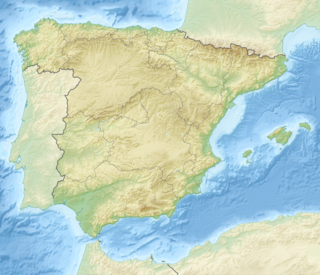
The Barun Goyot Formation or Baruun Goyot Formation is a geological formation dating to the Late Cretaceous Period. It is located within and is widely represented in the Gobi Desert Basin, in the Ömnögovi Province of Mongolia.

The Djadochta Formation is a geological formation situated in central Asia, dating from the Late Cretaceous Period. Laid down in the early Campanian, possibly starting in the latest Santonian, it is dated somewhat uncertainly at about 75-71 mya. The type locality are the famous "Flaming Cliffs", locally known as Bayanzag or Ulaan-Ereg.

Argiles et Grès à Reptiles Formation, also known as the Argiles Rutilantes Formation is an early Maastrichtian French geologic formation in the département of Var preserving the remains of several types of dinosaurs and other extinct organisms.

The Paw Paw Formation is a geological formation in Texas whose strata date back to the late Albian stage of the Early Cretaceous. Dinosaur remains are among the fossils that have been recovered from the formation.

The El Castellar Formation is a geological formation in La Rioja and Teruel, Spain whose strata date back to the possibly the Valanginian to the Barremian stages of the Early Cretaceous. Dinosaur remains are among the fossils that have been recovered from the formation.

The Sao Khua Formation is a middle member of the Khorat Group. It consists of an alteration of pale red to yellowish-gray, fine to medium-grained sandstone and grayish-reddish brown siltstone and clay. Rare pale red to light gray conglomerates, containing carbonate pebbles, are also characteristic of this formation. This geological formation in Thailand, dates to the Early Cretaceous age.

The Aguja Formation is a geological formation in North America, exposed in Texas, United States and Chihuahua and Coahuila in Mexico, whose strata date back to the Late Cretaceous. Dinosaur remains are among the fossils that have been recovered from the formation.
The Mooreville Chalk is a geological formation in North America, within the U.S. states of Alabama and Mississippi, which were part of the subcontinent of Appalachia. The strata date back to the early Santonian to the early Campanian stage of the Late Cretaceous. The chalk was formed by pelagic sediments deposited along the eastern edge of the Mississippi embayment. It is a unit of the Selma Group and consists of the upper Arcola Limestone Member and an unnamed lower member. Dinosaur, mosasaur, and primitive bird remains are among the fossils that have been recovered from the Mooreville Chalk Formation.
The Gres de Saint-Chinian is a geological formation in Aude and Hérault, France whose strata date back to the Late Cretaceous. Dinosaur remains are among the fossils that have been recovered from the formation.

The Arén Formation or Arén Sandstone is a geological formation in the Tremp-Graus Basin around Arén, Catalonia, Spain whose strata date back to the Late Cretaceous. Dinosaur remains are among the fossils that have been recovered from the formation. The formation dates to the Campanian to Maastrichtian and underlies the Tremp Group.

The Tremp Formation, alternatively described as Tremp Group, is a geological formation in the comarca Pallars Jussà, Lleida, Spain. The formation is restricted to the Tremp or Tremp-Graus Basin, a piggyback foreland basin in the Catalonian Pre-Pyrenees. The formation dates to the Maastrichtian to Thanetian, thus the formation includes the Cretaceous-Paleogene boundary that has been well studied in the area, using paleomagnetism and carbon and oxygen isotopes. The formation comprises several lithologies, from sandstone, conglomerates and shales to marls, siltstones, limestones and lignite and gypsum beds and ranges between 250 and 800 metres in thickness. The Tremp Formation was deposited in a continental to marginally marine fluvial-lacustrine environment characterized by estuarine to deltaic settings.

The Kallakurichi Formation, alternatively spelled as Kallankurichchi or Kallankurichi Formation, is a geological formation of the Ariyalur Group in Tamil Nadu, southern India whose strata date back to the Maastrichtian stage of the Late Cretaceous. Dinosaur eggs of Megaloolithus cylindricus are among the fossils that have been recovered from the sandy limestones of the formation.

The Wangshi Group is a geological Group in Shandong, China whose strata date back to the Coniacian to Campanian stages of the Late Cretaceous. Dinosaur remains are among the fossils that have been recovered from the group.

The Allen Formation is a geological formation in Argentina whose strata date back to the Late Cretaceous (middle Campanian to early Maastrichtian. Dinosaur remains are among the fossils that have been recovered from the formation.

The Villalba de la Sierra Formation is a Campanian to Maastrichtian geologic formation in Spain. Fossil dinosaur eggs have been reported from the formation, that comprises gypsiferous, grey, argillaceous mudstones and sandstones, deposited in a floodplain environment. Abundant titanosaurian remains, including Lohuecotitan were found in the formation. More than 10,000 fossil remains of various fishes, amphibians, lizards, dinosaurs, turtles, and crocodiles are also known from the site, one of the richest for the Late Cretaceous in Europe.

The Thomas Fork Formation is an Early Cretaceous (Albian) geologic formation in Wyoming. Fossil dinosaur eggs have been reported from the formation.
The Sigou Formation is a Late Cretaceous geologic formation in China. Fossil dinosaur eggs have been reported from the formation, including Dictyoolithus.

The Quxian Formation is a Santonian to Campanian geologic formation in China. Fossil dinosaur eggs have been reported from the formation. It is a unit of the Qujiang Group and dates to the Santonian through early Campanian.

The Mercedes Formation is a Late Cretaceous geologic formation of the Norte Basin in Uruguay. Fossil dinosaur eggs have been reported from the formation. The formation that reaches a thickness of about 100 metres (330 ft), overlies the Guichón Formation and is overlain by the Asencio Formation.

The Khodzhakul Formation is a Cenomanian aged geologic formation in Uzbekistan. Dinosaur remains are among the fossils that have been recovered from the formation. As well as those of Mammals. It is part of the same stratigraphic succession as the overlying Bissekty Formation.













